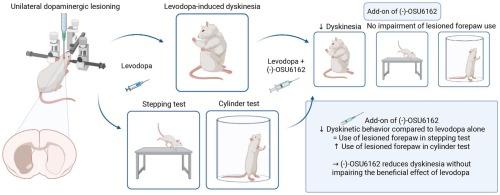The dopamine stabilizer (-)-OSU6162 attenuates levodopa-induced dyskinesia in the unilateral 6-hydroxydopamine rat model of Parkinson’s disease
IF 2.8
3区 医学
Q2 NEUROSCIENCES
引用次数: 0
Abstract
Levodopa-induced dyskinesia (LID) is a complication that occurs in many patients with Parkinson’s disease. (-)-OSU6162 is a clinically tolerable dopamine stabilizer with affinity for both dopaminergic D2 receptors and serotonergic 5-HT2A receptors which has been shown to counteract LID in non-human primates. To investigate whether (-)-OSU6162 can dampen levodopa-induced abnormal involuntary movements in the unilateral 6-OHDA rat model of Parkinson’s disease without impairing levodopa-induced improvement in motor functioning, female Sprague Dawley rats received complete unilateral lesioning of the medial forebrain bundle and were treated daily with levodopa/benserazide. Animals that developed dyskinetic behavior as assessed by involuntary abnormal movements following two weeks of treatment with levodopa/benserazide received either (-)-OSU6162 (30 mg/kg) or saline immediately prior to their next levodopa/benserazide dose. In a separate batch of animals, the same add-on treatment was given following three days of levodopa/benserazide administration prior to subjecting the animals to the stepping and cylinder tests. (-)-OSU6162 was found to significantly reduce levodopa-induced abnormal involuntary movements in dyskinetic rats without compromising the effect of levodopa in the stepping test. In conclusion, add-on of (-)-OSU6162 attenuates the expression of LID in the 6-OHDA rat model of Parkinson’s disease without affecting the antiparkinsonian effect of levodopa.

多巴胺稳定剂(-)- osu6162减轻帕金森病单侧6-羟多巴胺大鼠模型中左旋多巴诱导的运动障碍
左旋多巴诱导的运动障碍(LID)是许多帕金森病患者的并发症。(-)- osu6162是一种临床耐受的多巴胺稳定剂,对多巴胺能D2受体和5-羟色胺能5-HT2A受体都有亲和力,在非人灵长类动物中已被证明可以对抗LID。为了研究(-)- osu6162是否能抑制左旋多巴诱导的单侧6-OHDA大鼠帕金森病模型中异常不自主运动,而不损害左旋多巴诱导的运动功能改善,雌性Sprague Dawley大鼠接受完全单侧内侧前脑束损伤,并每天给予左旋多巴/苯醚肼治疗。在左旋多巴/苯塞拉肼治疗两周后,通过不自主异常运动来评估出现运动障碍行为的动物在下一次左旋多巴/苯塞拉肼治疗前立即接受(-)- osu6162 (30 mg/kg)或生理盐水。在另一批动物中,在进行步进和圆柱体试验之前,在左旋多巴/苯塞拉肼给药3天后给予相同的附加治疗。(-)- osu6162可显著减少运动障碍大鼠左旋多巴诱导的异常不自主运动,而不影响左旋多巴在步进试验中的作用。综上所述,添加(-)- osu6162可减弱6-OHDA大鼠帕金森病模型中LID的表达,但不影响左旋多巴的抗帕金森作用。
本文章由计算机程序翻译,如有差异,请以英文原文为准。
求助全文
约1分钟内获得全文
求助全文
来源期刊

Neuroscience
医学-神经科学
CiteScore
6.20
自引率
0.00%
发文量
394
审稿时长
52 days
期刊介绍:
Neuroscience publishes papers describing the results of original research on any aspect of the scientific study of the nervous system. Any paper, however short, will be considered for publication provided that it reports significant, new and carefully confirmed findings with full experimental details.
 求助内容:
求助内容: 应助结果提醒方式:
应助结果提醒方式:


